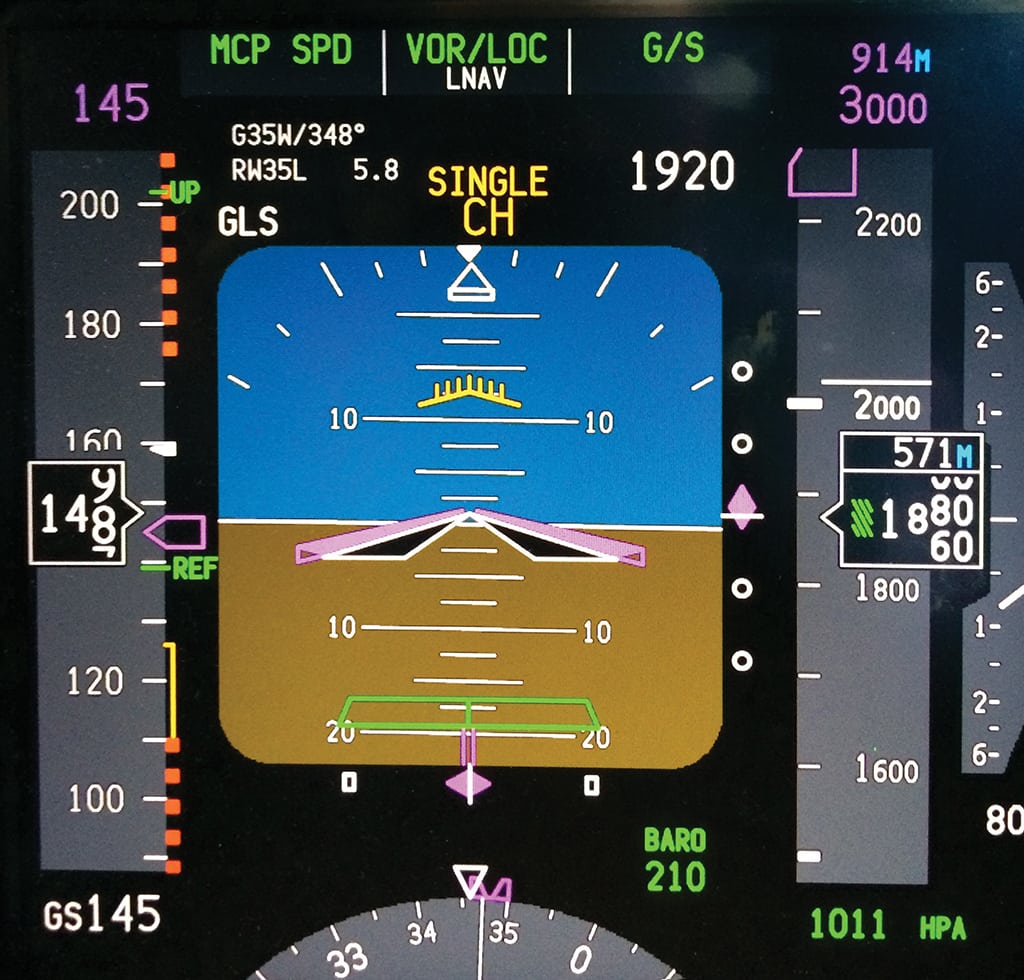[Avionics Today 05-26-2015] China’s Civil Aviation Administration (CAAC) has unlocked a new capability for reducing delays and increasing efficiency at the country’s most congested airports that could be ready for live operational use by the end of this year. A recent flight demonstration by Honeywell and Hughes Aerospace showed the benefits of the SmartPath Ground Based Augmentation System (GBAS) for next generation GPS-based precision landings.

A cockpit display shows the GLS approach into Pudong Airport used during the April flight demonstration. Photo: Hughes Aerospace.
Using a China Eastern Airlines Airbus A321 and a Shangdong Airlines Boeing 737-800, flight crews demonstrated the first ever Global Navigation Satellite System (GNSS) instrument approaches in China at the end of April. To enable these precision landings, SmartPath’s four ground-based antennas take an aircraft’s GPS signals and sends them to a single box located on the airport, which then correlates the signals for a high degree of integrity before beaming it back up to the aircraft for precision landing guidance.
“The CAAC, knowing that they needed to have some very flexible alternatives to the legacy [Instrument Landing System] ILS, they asked us to do some very innovative approaches with the system,” said Brian Davis, vice president of airlines, Asia Pacific at Honeywell Aerospace. “Honeywell and our partner Hughes Aerospace, we actually designed and created the flight paths into Pudong airport, not only for the standard approaches but we did four very flexible innovative approaches that have never been done by a commercial airline before. The first one was what we called a displaced threshold, the second was a variable glide-path.”
Hughes Aerospace CEO Chris Baur also noted that the demonstrations were done in Instrument Meteorological Conditions (IMC), providing a real world flight environment for the airline pilots.
“We built GLS approaches to all of the runways at Pudong,” said Baur. “We built GLS approaches to 35L and 35R and 17L and 17R. Then we did something that hasn’t been done anywhere before where we built multiple GLS approaches to one runway. For Runway 35L, we built a straight-in GLS approach and variable geometric path approaches, one with a 2.8 degree flight path angle and one with a 3.2 degree flight path angle.
Baur said the team also built two non-linear curved path, or XLS, approaches for Runway 35L, and the approach was flown to an automatic landing in IMC conditions. The trial flights provided a demonstration that exploited all of the benefits of the SmartPath technology, such as the ability to merge GLS with Required Navigation Performance (RNP) procedures to create a custom path to the runway based on the type of aircraft being flown.

Hughes Aerospace CEO Chris Baur and the flight crew from Shangdong Airlines that performed the precision landings demonstrations. Photo: Hughes Aerospace.
Davis says the implementation of the new procedures at Pudong can provide a model for dealing with wake turbulence issues from different aircraft as well. With heavier aircraft such as Boeing 747s, 777s or Airbus A380s dispersing an enormous amount of wake turbulence from the wings, aircraft in trail behind them are often forced to maintain very lengthy separation distances. An airport as busy as Pudong can face huge efficiency challenges when this happens.
“The variable glide-path allows the SmartPath station to send a signal to the aircraft that will allow it to fly a 2.8 or 2.9 or basically any glide-path you would like. It allows pilots to fly a much shallower glide-path than they would with an ILS,” said Davis. “SmartPath allows for up to 26 different approach combinations. That means for the same runway you can have an approach at a 2.8 degree glide-path. That’s where you bring the A380s and the Boeing 777s in. To the exact same runway, you can actually have the SmartPath station send a signal on a different channel to the smaller aircraft that will allow it to come in at a 3.1 degree glide-path, for example, so wake turbulence always disperses downward. If we bring those larger aircraft in at a shallow glide-path and the smaller aircraft in at a steeper glide-path, that means the 737 and A320 are always above the wake turbulence footprint of the larger aircraft.”
SmartPath has already been deployed in Australia, Brazil, Germany, Spain and Switzerland, and CAAC sees it as one of the key tools for managing future increases in air traffic. The International Air Transportation Association (IATA) expects China to have 415 million air travel passengers annually by 2016, which would be second only to the United States in domestic passenger volume.
According to Davis, the majority of aircraft coming off of production lines today are equipped with Multi-Mode Receivers (MMR) capable of performing GBAS landings and the localizer guidance and glide slope guidance for a SmartPath approach looks the same to a flight crew as if they were flying an ILS approach.
Going forward, the new procedures must now be certified by the CAAC and Air Traffic Management Bureau.
“We should have this station up and certified by the end of 2015, or the early part of 2016 with many airlines ready to fly the new GBAS procedures shortly thereafter,” said Davis.
– See more at: http://www.aviationtoday.com/av/commercial/China-Eastern-Shangdong-Demonstrate-GBAS-at-Pudong_85121.html#.VWXotflVikq

